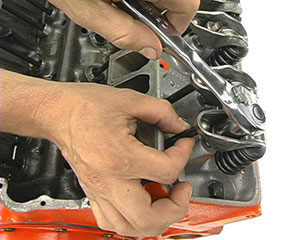When installing your new aftermarket cylinder heads, proper valve train geometry is critical to ensure maximum performance. To obtain proper geometry we need to look at pushrod length and rocker tip to valve stem tip alignment.
 Before we begin any of the procedures, there are several things that are needed before proceeding with the project.
Before we begin any of the procedures, there are several things that are needed before proceeding with the project.
Project Requirements:
1. Compressed thickness dimension of head gasket being used.
2. Camshaft that will be used for the project.
3. Lifters that will be used for the cam. (If this is a hydraulic lifter, a solid version of the lifter must be used with the same lifter cup depth dimension. If a solid version of the lifter is not available, then a pair of hydraulic lifters for the application will need to be modified so the pushrod cup will not compress. Remember, these lifters are for checking purposes only.
4. A pair of adjustable pushrods for the application. Example: If the cam manufacturer recommends a 7.760˝ length for the application, use an adjustable pushrod with a range of 7.500˝ to 8.700˝.
5. Rocker arms that will be used on the engine.
How to Check for Pushrod Length:
1. With the cam, crank and timing set installed, bring number 1 cylinder to top dead center on the compression stroke.
2. Install the two lifters that will be used for checking on the intake and exhaust lobes of the cam for number one cylinder.
3. Bolt the cylinder head on the block with no head gasket. (Do not torque the cylinder head, just make it snug).
4. Install the guide plate and rocker arm studs. Again, do not torque the studs, just make them snug.
5. As a starting point, adjust your checking pushrod to the same length recommended by cam manufacturer for the cam and lifter combination you are using.
6. Install the checking pushrods in the engine.
7. Take your black magic marker and color the tips of the intake and exhaust valves.
8. Install the intake and exhaust rockers and adjust the rockers to zero lash.
9. Rotate the engine over by hand several times.
10. Remove the rockers and note the contact pattern the rockers made on the tip of the valve.
11. If the pattern is centered on the valve tip, pushrod length is ok. If the pattern is wide to the exhaust side of the head, your pushrod length is too long. If the pattern is wide to the intake side of the head, the pushrod is to short.
12. If adjustments need to be made, remove the rockers, recolor the tips of the valves, lengthen or shorten the adjusting pushrods as needed, reinstall the rockers and rotate the engine over again by hand. Repeat the process until the desired pattern is achieved.
13. Once the desired pattern is achieved, remove the checking pushrods from the engine and measure them. Take that measurement and add the compressed thickness of the head gasket being used. The sum of this will be the correct pushrod length for your combination.
Rocker Tip to Valve Stem Alignment:
1. With the cylinder head still bolted on the engine, loosely install the guide plate and studs for number one cylinder.
2. Bring number one cylinder to top dead center on the compression stroke.
3. Install the correct length pushrods for the application.
4. Reinstall the rocker arms and set to zero lash.
5. Now you want to check and make sure the rocker arm tip is centered on the valve tip. If there is any misalignment problems, the guide plate can be moved side to side or fore and aft to achieve proper alignment.
6. Once proper alignment has been achieved, remove the rocker arms and torque the studs to the proper value. Reinstall the rockers and verify that the guide plates did not move during the torquing process. Repeat the procedures for the other cylinders.
7. Due to varying tolerances in lifter bore indexing, adjusting the guide plate as mentioned above may not allow enough shift to achieve proper rocker tip to valve stem tip alignment. If this is the case, Isky adjustable guide plates may be used in the small block Ford and small block Chevy applications. Since there are no adjustable guide plates available for the Big Block Chevy, the only alternative would be to slightly bend the guide plate in the center to achieve proper alignment. Since the guide plates are made of a hardened material, CAUTION should be taken when bending the guide plate on Big Block Chevys as cracking may result.
Tech Tip courtesy of World Products (www.worldcastings.com).













